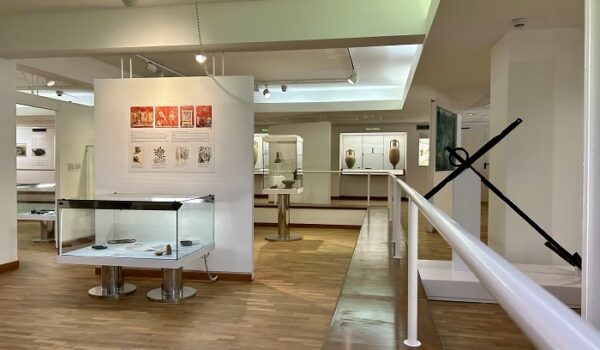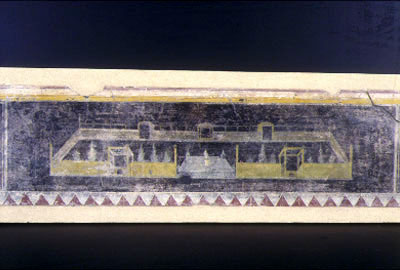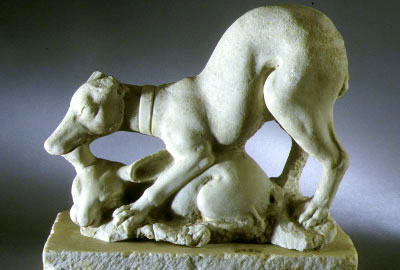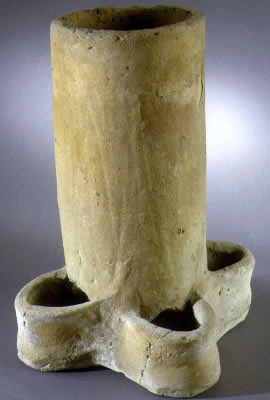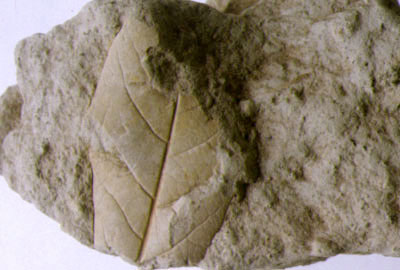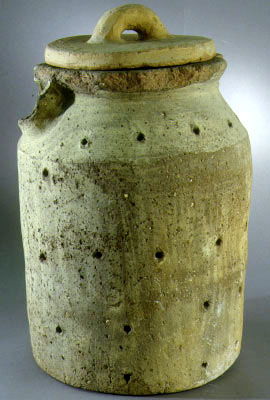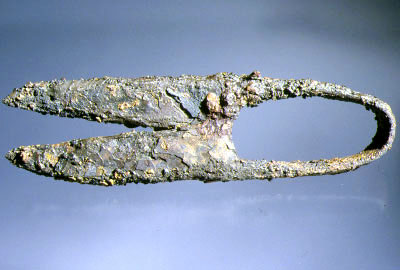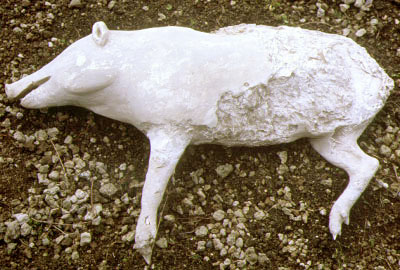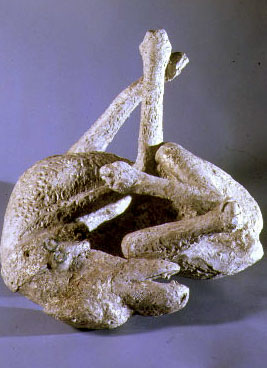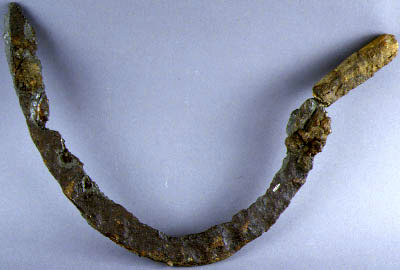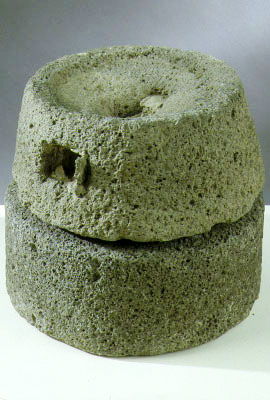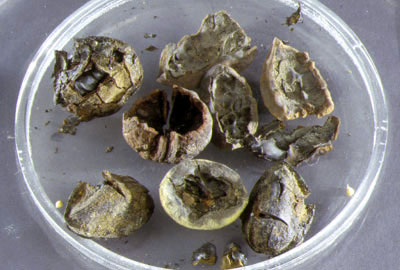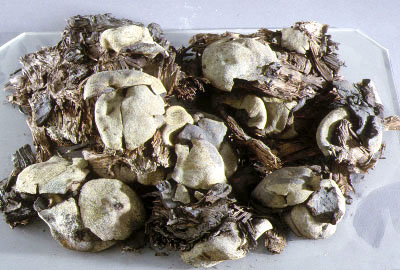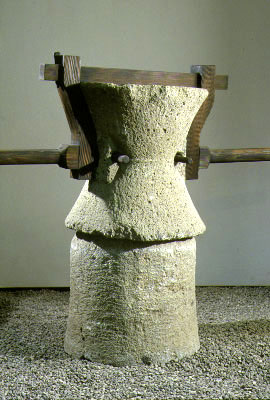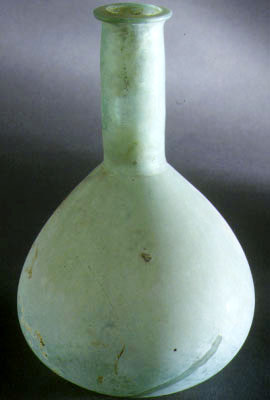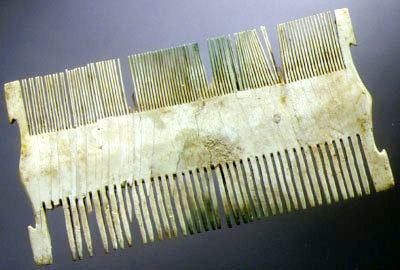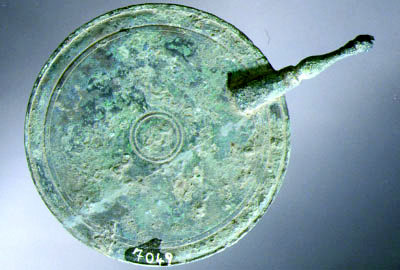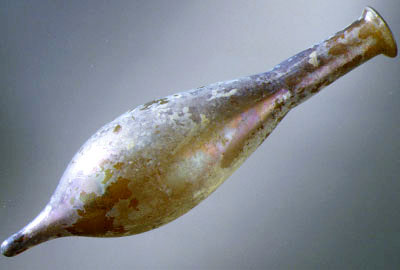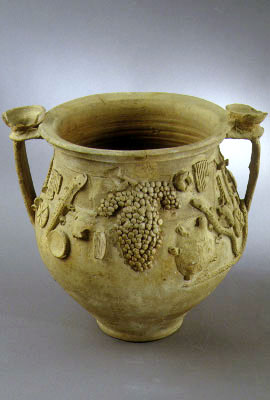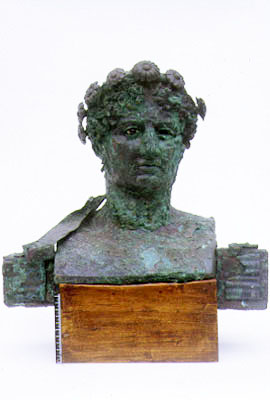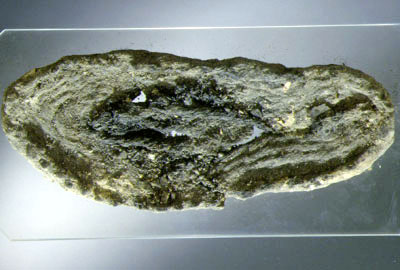The finds displayed in the first Room allow the main characteristics of the Vesuvian area during the Roman epoch to be reconstructed, as well as giving us an understanding of how man took advantage of the abundant natural resources of the territory.
The finds also document the condition of the area, the partially extinct flora and fauna, the Vesuvian territory, the agricultural and pastoral activities, and lifestyle of the ancient Vesuvians and their relationship with the environment in general.
| The Sea and the Coast The finds document the practice of fishing and the use of botanical species that grew along the coast and the mouth of the Sarno river.. |
|
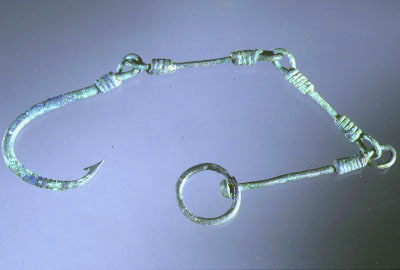 |
A Bronze Hook with Chain This was found together with other objects (hooks, net weights, a knife, remains of a wicker basket) that were part of the fishing tackle (instrumentum piscatorium) belonging to an inhabitant of a country house located in the southern outskirts of Pompeii. |
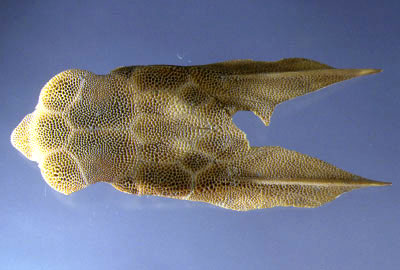 |
A Fishbone Helmet Part of a fish skeleton from the species Dactylopterus volitans L., the flying gurnard, found inside a building in Pompeii. |
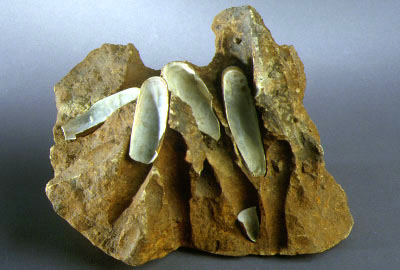 |
Rock with Mussels A portion of marine rock with date mussels (Lithophaga lithophaga L.) originating from the Pompeian coast.
|
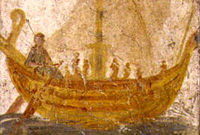 |
Wall Painting with Aphrodite Frescoed panel showing a deity on a transport vessel. At the bottom there was a Greek inscription, no longer visible, naming her 'Aphrodite the protectress'. The painting was found in the House of Lesbianus in Pompeii. |
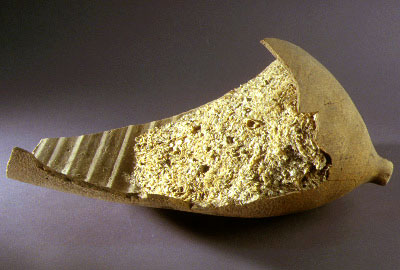 |
Fragment of a Clay Amphora Containing Garum Part of the body of a transport amphora with remnants of its contents of scales, fishbones and a solid residue of garum which is a fish-sauce made through the maceration of small fish, also produced in Pompeii and widely used in Roman cuisine. |
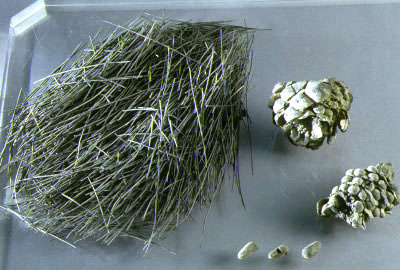 |
Pine Needles, Cones and Pine Nuts Plant remains found in the excavations of the city of Herculaneum, attesting the presence of the species Pinus pinea L. |
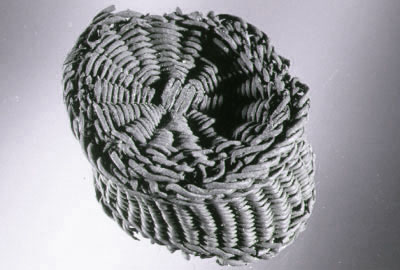 |
Basket Made of Plant Fibre Small miniature reed basket, with a lid, found in a domus in Pompeii.
|
|
The Plain |
|
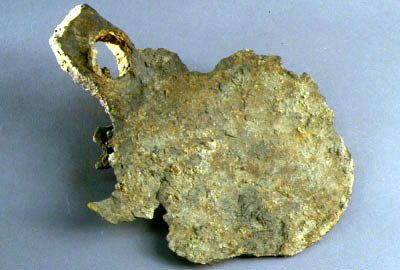 |
Iron Hoe A work tool found in a building in Pompeii used to shape the soil. A wooden handle would have been fitted through its eye. |
 |
Marble Tombstone Reused in a tomb in the Pompeian necropolis at Porta Nocera. The epigraph commemorates Popidius Nicostratus, an agrimensor (land surveyor), as proven by the tools sculpted on his tombstone: a groma, stakes, and a plumb line, of which only the cord is still preserved.
|
|
The Hilly Region |
|
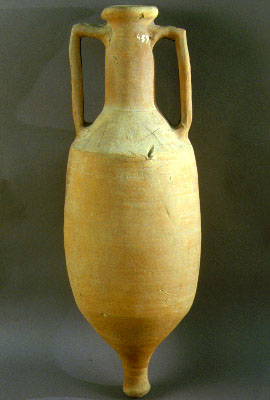 |
Wine Amphora Clay transport amphora, which can be ascribed to the type Dressel 2-4, used to transport wine.
|
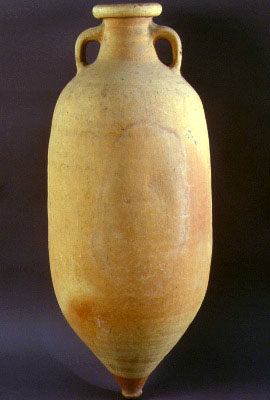 |
Oil Amphora Clay transport amphora, which can be ascribed to the type Ostia LIX, used to transport oil.
|
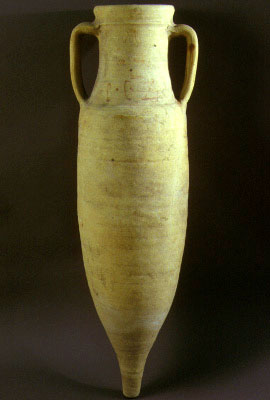 |
Fruit Amphora Clay transport amphora, which can be ascribed to the Pompeian type Schöne 4. The inscription painted on its neck describes its content (mal(a) cum(ana) ver(a) meaning real apples from Cumae), the weight, and the initials P.C.Z. which could possibly be those of the producer.
|
 |
Olives Olives (Olea europaea L.) with the seed and part of their pulp still intact. They were used as food.
|
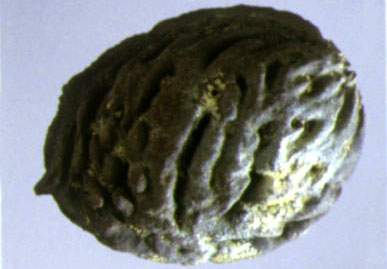 |
Peach Stone A peach stone found in a domus in Pompeii. The plant remains document the cultivation in the Vesuvian area of this botanical species (Prunus persica (L.) Batsch) which, according to ancient sources, was indigenous to Persia.
|
|
Mountains The peak of Mount Vesuvius was covered with woods inhabited by wild animals. Hunting, picking berries, plants and mushrooms, and wood cutting, were the main human activities carried out in the area. |
|
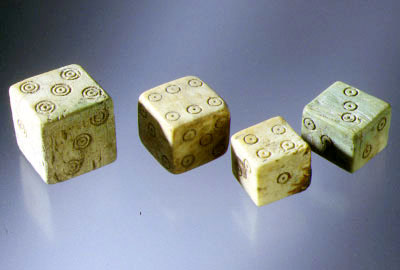 |
A Set of Four Bone Dice Found in a building in Pompeii which served as hotel, these are one of the many objects that could be produced with bone and horn available thanks to hunting. |
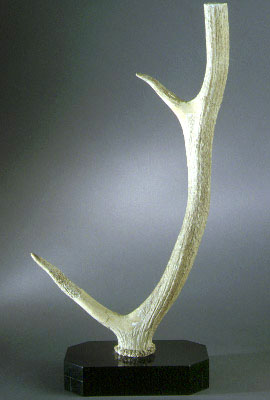 |
Corna di cervo Palco di cervo, rinvenuto in una bottega di Pompei, ai piedi del bancone di vendita ed utilizzato probabilmente come trofeo.
|
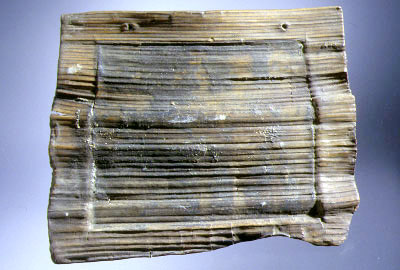 |
Wax Tablet |
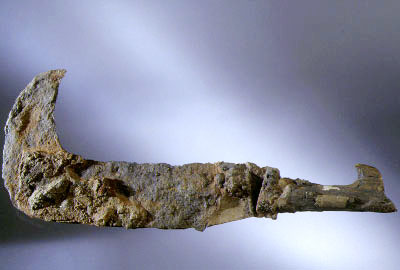 |
Billhook A billhook with an iron blade and a wooden handle still preserved, used for pruning branches and trunks. It was found in the House of the Menander in Pompeii.
|
|
Urban Green In the Vesuvian cities, the houses had green spaces of various sizes. There were small vegetable patches for officinal plants, or large gardens populated by domestic animals and decorated with marble furnishings. |
|
|
|
Wall Painting with Garden The frescoed panel reproduces the layout of a garden and highlights the attention the ancient population of Pompeii paid to topiary. It was originally on the external portico on the west side of the Villa Imperiale in Pompeii and can be ascribed to the third Style.
|
|
|
Marble Statue |
|
|
Clay Feeding Trough A clay feeding trough for small courtyard animals that populated Pompeian gardens. |
|
|
Cast of a Leaf The mark of a holm-oak leaf (Quercus ilex L.) remained on a layer of compact cinerite dating back to the 79 A.D. eruption. The tree had decorated the garden of a Stabian villa. |
|
Crops and Livestock The finds displayed show the breeding of several domestic and wild species and that of the cultivation of cereals, fruits and vegetables in the Vesuvian area. |
|
|
|
Glirarium A lidded, clay, cylindrical container with holes on its walls was used for breeding dormice. |
|
|
Iron Shears Iron shears used for fleecing was found in a Pompeian domus. Similar to those that are still in use today, they were used for cutting wool and widely traded in Pompeii. |
|
|
Cast of a Pig Plaster cast made of a pig skeleton during the excavation of the country villa located at Villa Regina in Boscoreale. It testifies to the presence of pig farms in the Vesuvian area.
|
|
|
Cast of a Dog Plaster cast of a dog made during the excavation of the domus of Vesonius Primus in Pompeii in the 19th century. The collar is still intact and was used to tie the dog onto a chain. It prevented the dog from running away during the 79 A.D. eruption.
|
|
|
Iron Scythe A scythe with a long, pointed blade and a wooden handle which is still preserved. It was used for harvesting and cutting the grass.
|
|
|
Carbonised Bread |
|
|
Handmill Made of Volcanic Rock |
|
|
Figs |
|
|
Nuts |
|
|
Pomegranates |
|
|
Donkey Millstone made of Volcanic Rock |
|
Medicine |
|
|
|
Bronze Scalpel Handle |
|
|
Glass Vase |
|
Perfumes and Make Up |
|
|
|
Bone Comb |
|
|
Bronze Mirror |
|
|
Glass Unguentarium |
|
|
Glass Unguentarium |
|
|
Glass Unguentarium |
|
Sacred Plants and Animals |
|
|
|
The ‘Magical Vase’ |
|
|
Bronze Bust |
|
Types of Textile and Dye-works |
|
|
|
Esparto Sandal |


